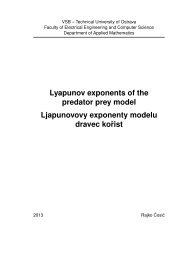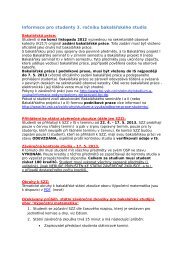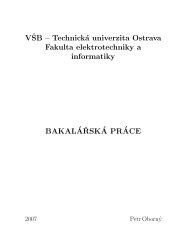The Boundary Element Method for the Helmholtz Equation ... - FEI VÅ B
The Boundary Element Method for the Helmholtz Equation ... - FEI VÅ B
The Boundary Element Method for the Helmholtz Equation ... - FEI VÅ B
Create successful ePaper yourself
Turn your PDF publications into a flip-book with our unique Google optimized e-Paper software.
30 3 <strong>Boundary</strong> Integral <strong>Equation</strong>sIntroducing <strong>the</strong> integral operatorsV κ : H −1/2 (∂Ω) → Hloc 1 (Ω), ( V κ s)(x) :=W κ : H 1/2 (∂Ω) → Hloc 1 (Ω), (W κt)(x) :=∂Ω∂Ωv κ (x, y)s(y) ds y , (3.3)∂v κ∂n y(x, y)t(y) ds y (3.4)with density functions s, t: ∂Ω → R allows us to rewrite <strong>the</strong> representation <strong>for</strong>mulae (3.1)and (3.2) asu = V κ γ 1,int u − W κ γ 0,int u in Ω,u = − V κ γ 1,ext u + W κ γ 0,ext u in Ω ext .Remark 3.5. <strong>The</strong> operators V κ and W κ are usually called <strong>the</strong> single layer potential operatorand <strong>the</strong> double layer potential operator, respectively. However, <strong>the</strong>re is a naming conflict.In <strong>the</strong> following sections we also use <strong>the</strong>se terms <strong>for</strong> composite operators γ 0 Vκ and γ 0 W κ ,where γ 0 denotes <strong>the</strong> interior or exterior Dirichlet trace operator.<strong>The</strong>orem 3.6. <strong>The</strong> operator V κ : H −1/2 (∂Ω) → Hloc 1 (Ω) is linear and continuous. Hence,<strong>for</strong> bounded domains <strong>the</strong>re exists a constant c ∈ R + such that∥ V κ s∥ H 1 (Ω) ≤ c∥s∥ H −1/2 (∂Ω)<strong>for</strong> all s ∈ H −1/2 (∂Ω).Moreover, <strong>for</strong> all s ∈ H −1/2 (∂Ω) <strong>the</strong> function V κ s satisfies <strong>the</strong> <strong>Helmholtz</strong> equation in <strong>the</strong>weak sense (including <strong>the</strong> Sommerfeld radiation condition in <strong>the</strong> case of an unboundeddomain).<strong>The</strong>orem 3.7. <strong>The</strong> operator W κ : H 1/2 (∂Ω) → Hloc 1 (Ω) is linear and continuous. Hence,<strong>for</strong> bounded domains <strong>the</strong>re exists a constant c ∈ R + such that∥W κ t∥ H 1 (Ω) ≤ c∥t∥ H 1/2 (∂Ω)<strong>for</strong> all t ∈ H 1/2 (∂Ω).Moreover, <strong>for</strong> all t ∈ H 1/2 (∂Ω) <strong>the</strong> function W κ t satisfies <strong>the</strong> <strong>Helmholtz</strong> equation in <strong>the</strong>weak sense (including <strong>the</strong> Sommerfeld radiation condition in <strong>the</strong> case of an unboundeddomain).<strong>The</strong> preceding <strong>the</strong>orems allow us to seek <strong>the</strong> solution to <strong>the</strong> <strong>Helmholtz</strong> equation in <strong>the</strong><strong>for</strong>m u = V κ s or u = W κ t with unknown density functions s, t. This approach gives rise toindirect boundary element methods, which will be mentioned later.Properties of <strong>the</strong> above given potential operators, which will be discussed in <strong>the</strong> followingsections, can be found in [12] (see also [9] and [18]). <strong>The</strong>se properties will be crucial<strong>for</strong> <strong>the</strong> derivation of boundary integral equations (both direct and indirect), which will beused <strong>for</strong> <strong>the</strong> computation of <strong>the</strong> missing Cauchy data.









